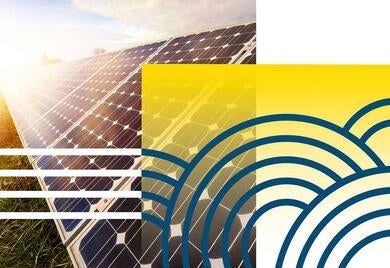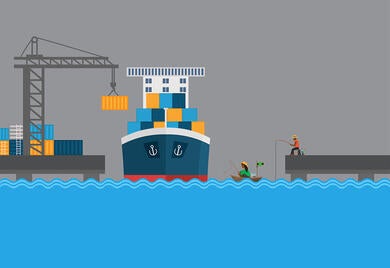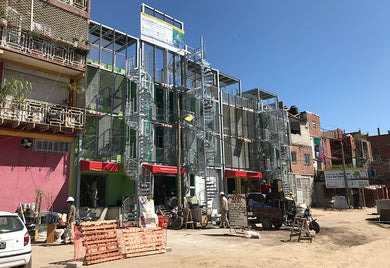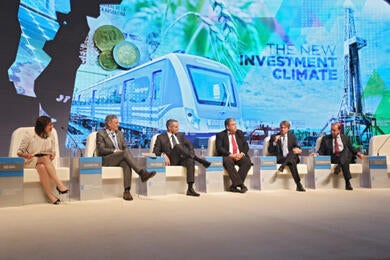
How to Implement Infrastructure Projects in the COVID-19 Era
IDB Invest's new guide for infrastructure projects has proven its usefulness in Colombia and can help decision-making during the pandemic. The guide helps to assess and prevent risks at a time when the region needs such projects more than ever.

Saving Infrastructure Projects Amidst the Pandemic
The development of transport infrastructure depends on the commitment of construction companies and financial institutions. Their collaboration is key for projects in Paraguay and Uruguay to move forward, and has major positive impacts on trade and employment.

The way to build the future is to invest in it
The world is evolving at exponential speeds. Technology is contributing to a future marked by major social and economic improvements. This is especially true in Latin America and the Caribbean. Mobile subscribers in the region have increased 800% in the last five years. In 2017, financial technology (fintech) companies transacted more than US$90 billion in transactions in the region, an amount that surpasses Panama’s gross domestic product (GDP). And the region already leads the world in clean energy. Private sector innovation and competition have led to much of these technological advances, but development challenges remain. The region’s productivity lags its East Asian peers. Financing gaps, such as infrastructure, amount to billions of dollars or over 2% of the region’s GDP, while women-led businesses are still less likely to access financing than their male counterparts. The speeds, flexibility and power of technology have their limits. Our clients in the region’s private sector have ambitious goals, and it will take a range of solutions to achieve them. Designing for trust and client-focus For example, AirBnB, a hotel retailer, has grown from zero to 24 million annual guests in less than a decade. AirBnB does rely on technological platforms to unite lodging supply with demand, but it is the company’s ability to foster trust that gave it market leadership. This means fostering trust not only in the company to match people and process payments but also fostering trust among complete strangers who share their homes with one another. AirBnb, like Netflix, iTunes and so many others, remind us that technology alone is not the real disruptor. Designing for trust and the client experience is much bigger. Staying relevant while building a better future The digital disruption leaves no room for complacency. In addition to upending the hotel industry, it has taken over taxi and retail services highlighting that the quest to stay relevant is more difficult than ever. These changes, coupled with cash strapped governments and geopolitical shifts, put pressure on development banks to turn the billions on their balance sheets into trillions of development finance. To compete in today’s world and achieve our collective development goals, we must find ways to solve tomorrow’s challenges. A client experience defined by process agility, product flexibility and a sense of trust will allow development banks to stay relevant in changing times. Staying relevant includes more equity and quasi-equity, such as mezzanine and subordinated debt, to grow companies and allow them to create jobs. It includes engaging institutional investors through products like B-Bonds and demonstrating that their investments in emerging markets can perhaps outperform their developed market comfort zone. Staying relevant includes offering more local currency so that borrowers can repay in the currency they are generating cash flow. We also work in a world of liquidity where cash is no longer king. Providing advisory and knowledge to our clients will be what adds value and defines our development impact. These are some of the ways development banks can better tailor client experiences, reduce risks and allow clients to focus on stimulating development. Today, we are launching the most consequential makeover in our history. We are revamping our vision, strategy, products, sectors and culture under the new brand IDB Invest. This is about our commitment to take the best of what works. Our synergies with IDB coupled with product flexibility and process agility incorporate the best of the public and private sectors. Our transformation may be facilitated by technology, but it will be driven by a quest to put clients at the center and earn their trust and business in return. This will ensure the development impact for all our stakeholders. Subscribe to receive more content like this! [mc4wp_form]

Making social investments count
When someone searches the word “sustainability” online, images of wind farms, trees, and waterways dominate the results. What is often missing from these photographs are people. It remains a challenge to break the habit of equating sustainability just with the environment. Sustainability, at its core, is something that should conjure not just these images but illustrations depicting people and the benefits of a positive healthy community. The private sector, in particular, should desire sustainable communities since this can often translate into better economic performance. According a study conducted by Deutsche Asset Management and the University of Hamburg, there is a positive correlation between good environmental, social and governmental practices and improved corporate financial performance. In other words, it literally pays to incorporate sustainability at the core of one’s primary business. An example of this is the Kingston Freeport Terminal Limited (KFTL) sustainable program at the Kingston harbor, in Jamaica. After winning the 30-year concession to operate the Kingston Container Terminal, KFTL saw an immediate need to seek out partners to become the catalysts for development in the harbor. Making room for sustainable infrastructure The first field visits to KFTL were challenging. I arrived at Greenwich, one of the largest fishing beaches in the harbor, to be immediately struck by the complexity of its location. Situated between the harbor and the state oil refinery on a slim piece of land, I wondered how these two could coexist. The visible conditions were extremely poor: no basic infrastructure and a landscape dotted with makeshift wooden shacks. Despite this, there was a real community there; fisherfolk (as they are called in Jamaica), who for several generations have made their livelihood from fishing these waters, have adapted to an extremely challenging environment. They are the largest —more than 4,000— and most economically vulnerable stakeholder. [clickToTweet tweet="Private sector should desire sustainable communities since they improve economic performance" quote="Private sector should desire sustainable communities since they improve economic performance" theme="style1"] As we began our conversations with the fisherfolk the tension was clear. The main concern was about the impact in their business, since previous experiences negatively affected their fish catch for more than a year. To define a social investment strategy and successfully structure the deal, IDB Invest (formerly known as Inter-American Investment Corporation) began working with KFTL. The purpose was to help the company to develop a long-term sustainability approach to ensure that investments produce benefits not only to private sector companies working with us but also to society. Coming to a sustainable agreement KFTL concession allows the company to modernize the harbor and to conduct dredging operations to receive larger Panamax vessels, which are designed to pass through the Panama Canal. These operations will increase employment opportunities for the surrounding communities, and help port operators engage with other stakeholders to ensure long-term sustainability for all harbor users. However, the creation of a long-term sustainability program was also a main objective for the company. This will be paramount to enhance relationships among port stakeholders, and invest in improving fisherfolk conditions. To increase social inclusion and incentivize an open dialogue, we recommended the creation of a committee with the fisherfolk fishing beach representatives, the Jamaican Port Authority, and KFTL staff. The committee has defined three main activities to revitalize the harbor: 1) provide livelihood support during dredging activities; 2) conduct solid waste cleanup of fish nurseries within the harbor; and 3) develop a fish sanctuary and artificial reef outside the harbor. These programs are still in their planning phases. However, their investments will provide long-lasting benefits to a community that has experienced declining incomes and economic vulnerability for years. On the business side, the 830 government workers from the port were employed by KFTL, and as container traffic increases additional labor growth is expected. Moreover, since the handover an additional 40 staff have been hired in various positions throughout the company. Ultimately, KFTL commitment will help shaping what it means to be a sustainable company while simultaneously providing a tangible improvement to an extremely vulnerable population. This is one clear example of how the private sector can leverage its resources to create economic benefits not only for itself, but also broad societal benefits for key stakeholders. Subscribe to receive more content like this! [mc4wp_form]

How we incentivize social inclusion through Sustainable Infrastructure? The case of Villa 31
Recently I visited the Villa 31 in Buenos Aires, Argentina. It is a poor and informal neighborhood located at approximately 500 meters from La Recoleta, one of the most sophisticated areas of the Argentinian capital. Despite this proximity, near 45,000 residents at Villa 31 have lived in isolation, not accepted as true “porteños” by their neighbors due to the social and economic characteristic of their community. My hope is that a new development project of sustainable infrastructure in the area changes this scenario. During my visit, I met fantastic people, but I experienced a strong mix of feelings. 20 years ago, I worked on an urban rehabilitation project in Brazil, which provided new homes, electricity, water, and sanitation to hundreds of low income people. By the end of the project, high-level dignitaries from the Government and other entities visited the new homes. One of them approached a woman benefited by the project and asked: “Are you happy? Is your life better?” She looked at him and said: “No, I am much worse off today. Before the project, I lived in a shack, I had no light, no water, no job, but no bills either. Now I have been given this nice house with bills to pay, but I still do not have a job. I do not know what to do”. 20 years after, I still carry this experience with me, even though we have learned a lot about urban development and inclusion projects ever since. The number of success stories has been growing, but its nature remains rather complex and represents a significant challenge to governments, policy makers, and financiers alike. According to an Inter-American Development Bank report: “Poverty-targeted projects that did not include specific objectives to reach excluded populations often reinforced their exclusion”. We must avoid this at all cost and work on the inclusion since the beginning. From Villa 31 to Villa “Thirty and Everyone” Working on sustainable infrastructure is not only about building new houses, but to improve the entire ecosystem around them to mobilize more human and economic resources that help people to break the poverty cycle. Villa 31 is not an isolated case. In Latin American and the Caribbean cities, informal areas can concentrate up to 50% of its habitants, and according the estimates, these number will keep rising. Development processes must include habitants’ perspective. Local communities have a voice, and the fact that we are listening to them makes a huge difference in terms of long-term acceptance, appropriation and viability. During my days at the Villa, I saw the construction taking place and the physical infrastructure being implemented. The work on water, sanitation, accessible roads, energy and electrified systems at Villa 31 is allowing its inclusion into Buenos Aires. More importantly, I saw people smiling and the pride on their eyes not only for the new structures, but for having a voice and being really included. So much that the initiative has been called Treinta y Todos (“Thirty and Everyone”) by Horacio Rodríguez Larreta, Buenos Aires city Mayor. This project has renewed people’s belief that their children would have the opportunity to live a different and better life, which is an essential success factor in such complex situation. Walking the talk at the Villa The feeling when leaving Villa 31 was completely different to what I felt 20 years ago, after our conversation with that woman in Brazil. I saw a high sense of trust and hope, so high that residents are already investing their own capital on improving their homes and establishing new business, such as: restaurants or beauty shops. Complementary initiatives like these are key, considering near 70% of the urban population of Latin America and the Caribbean works in the services sector, according UN-Habitat. A new socio-economic dynamic is developing, and some important external factors are fueling the process forward. The decision to establish a major government office building from the Education Ministry at the Villa provides a strong signal. However, it is not the only one. At the Inter-American Development Bank Group (IDB Group) we firmly believe in ‘walking the talk’, and the construction of the new Argentinian representation in Villa 31 shows it. This is a bold sign of commitment to the country and, more importantly, to the people. As part of the IDB Group, IDB Invest (formerly known as Inter-American Investment Corporation) is mobilizing resources and creating financial tools to stimulate private investments on these projects. Other public and private institutions should learn about the changes at the Villa, and hopefully decide to stand up and support this process too. [gallery type="slideshow" link="file" size="full" ids="7752,7753,7755,7757,7758,7759"] Subscribe to receive more content like this! [mc4wp_form]

How Argentina can attract the private sector
This week I had the opportunity to participate in the Argentina Business and Investment Forum in Buenos Aires. The world has been watching as the country took center stage to start the conversation with the private sector and discuss ways to open its markets to the world.